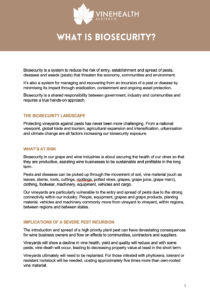Biosecurity is a system to reduce the risk of entry, establishment and spread of pests, diseases and weeds (pests) that threaten the economy, communities and environment. It’s also a system for managing and recovering from an incursion of a pest or disease by minimising its impact through eradication, containment and ongoing asset protection.
Biosecurity is a shared responsibility between government, industry and communities and requires a true hands-on approach.
The biosecurity landscape
Protecting vineyards against pests has never been more challenging. From a national viewpoint, global trade and tourism, agricultural expansion and intensification, urbanisation and climate change are all factors increasing our biosecurity exposure.
What’s at risk?
Biosecurity in our grape and wine industries is about securing the health of our vines so that they are productive, assisting wine businesses to be sustainable and profitable in the long term.
Pests and diseases can be picked up through the movement of soil, vine material (such as leaves, stems, roots, cuttings, rootlings, potted vines, grapes, grape juice, grape marc), clothing, footwear, machinery, equipment, vehicles and cargo.
Our vineyards are particularly vulnerable to the entry and spread of pests due to the strong connectivity within our industry. People, equipment, grapes and grape products, planting material, vehicles and machinery commonly move from vineyard to vineyard, within regions, between regions and between states.
Implications of a severe pest incursion
The introduction and spread of a high priority plant pest can have devastating consequences for wine business owners and also have flow on effects to communities, contractors and suppliers.
- Vineyards will show a decline in vine health, yield and quality will reduce and with some pests vine death will occur, leading to decreasing property value at least in the short term.
- Vineyards ultimately will need to be replanted. For those infested with phylloxera, tolerant or resistant rootstock will be needed, costing approximately five times more than own-rooted vine material.
- Wine businesses will be subjected to increased compliance in order to operate. This will come with increased costs of doing business through having to install disinfestation equipment, needing more equipment due to limited sharing opportunities and taking into account time to disinfest. Time to undertake compliance requirements will also need to be factored into daily capacity of operations, such as area to harvest in a day, volume of grapes to process in a day, or area to prune in a day. Designated routes of travel may also lengthen turnaround times for cartage.
- Increased regulation may restrict movement of grapes from a vineyard, meaning they cannot be processed. Further restrictions may be placed on the movement of grape products between wineries and the movement of grapevine planting material from a vineyard or nursery.
- Wine brands with old vines at their core will no longer be able to use them as a marketing strategy or be able to use their old vines from which to propagate new vineyards.
- The continuation of single vineyard wines is at risk, as are blending opportunities for winemakers.
Your role
Protection of South Australia’s wine industry from phylloxera and other significant pests and diseases can only be achieved through the collective efforts of industry and government.
Please ensure you always maintain focus on compliance with South Australia’s Plant Quarantine Standard when importing items into the state that can carry pests and disease. We also ask you to strongly encourage your neighbours, suppliers and community to follow the rules. We urge you to also continue your focus on implementing strong farm-gate hygiene practices to the collective benefit of the South Australian wine industry.
